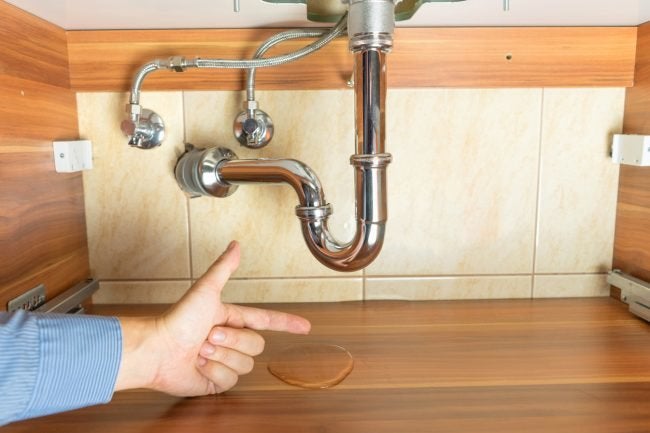How to Check If Your Home Has a Hidden Leakage
How to Check If Your Home Has a Hidden Leakage
Blog Article
This post down below pertaining to Hacks to detect leaks is extremely captivating. Don't miss it.

Early detection of dripping water lines can reduce a prospective disaster. Aside from conserving you cash, it will reduce the irritation as well as disappointment. The moment you find a leak, calling your plumber for repair work is the best solution. Some little water leaks may not be noticeable. If you can not find it with your naked eyes, here are some hacks that aid.
1. Check Out the Water Meter
Inspecting it is a surefire way that aids you find leaks. If it moves, that shows a fast-moving leakage. This implies you may have a sluggish leakage that might even be below ground.
2. Inspect Water Consumption
Analyze your water expenses and track your water intake. As the one paying it, you must notice if there are any kind of inconsistencies. If you spot sudden changes, in spite of your consumption coinciding, it suggests that you have leaks in your plumbing system. Bear in mind, your water bill must drop under the exact same array monthly. An abrupt spike in your bill suggests a fast-moving leakage.
At the same time, a constant increase monthly, despite the exact same routines, reveals you have a slow-moving leakage that's additionally gradually rising. Call a plumber to thoroughly check your home, particularly if you feel a cozy location on your floor with piping underneath.
3. Do a Food Coloring Test
30% comes from commodes when it comes to water intake. Examination to see if they are running effectively. Decline specks of food color in the tank as well as wait 10 mins. If the shade somehow infiltrates your dish during that time without flushing, there's a leakage between the storage tank and bowl.
4. Asses Exterior Lines
Don't neglect to examine your outside water lines too. Needs to water leak out of the connection, you have a loosened rubber gasket. One tiny leakage can squander loads of water and also surge your water costs.
5. Check and Examine the Situation
House owners need to make it a practice to examine under the sink counters and even inside closets for any type of bad odor or mold and mildew development. These two red flags suggest a leakage so prompt attention is needed. Doing regular inspections, even bi-annually, can save you from a major issue.
Extra importantly, if you know your home is currently old, maintain a watchful eye on your heating systems, tubes, pipelines and so on. Check for discolorations and also damaging as the majority of devices as well as pipelines have a life expectancy. They will certainly also naturally degrade due to damage. Don't wait for it to rise if you think dripping water lines in your plumbing system. Call a professional plumber immediately so you do not wind up with a horrible mess in your house.
Early detection of leaking water lines can alleviate a possible calamity. Some little water leakages might not be noticeable. Examining it is a proven means that aids you find leakages. One small leak can squander loads of water and spike your water costs.
If you believe dripping water lines in your plumbing system, don't wait for it to escalate.
How to Know If Your Home Has a Hidden Leak
Water Meter Reveals Inexplicable Water Usage
If you’d like to test whether or not there’s a leak somewhere in your home, you can do this using your water meter. Here is how to conduct the test:
Don’t use any water in your home for at least 30 minutes; this also means not turning on faucets or water-using appliances.
Go outside, and check your water meter for activity.
If your water meter shows that there was activity, even though no one was using any water, this proves that there is a leak in your home.Visible Mold or Mildew Growth
Leaks behind walls create moist, dark environments that allow mold and mildew to grow and thrive. Eventually, you might see mold growth forming on the wall closest to a hidden leak.
If mold is growing in an area that receives a high amount of moisture, such as a bathroom, it may simply be an indication that better ventilation is needed. However, if you see mold growth on a wall or the ceiling in an area where you would not expect, you probably have a hidden leak.
Musty, Mildew Odor
Sometimes you might not be able to see the mold or mildew that is growing as a result of a leak. However, the smell can give the problem away just as easily. If you catch a whiff of something musty, there’s a good chance that old water is collecting somewhere in your home that you can’t see.
Stained/Warped Walls, Ceilings, or Floors
When your home soaks up water, a variety of red flags can become visible, including ceiling stains, bubbling drywall, warped walls, and sagging floors. While these issues can be caused by excess humidity, they can also be signs that a pipe or plumbing connection has started leaking behind your walls.
Inexplicably High Water Bill
After a while, you get a general sense for what your water bill should be. If you own a pool or sprinkler system, your bill will tend to be higher during summer. However, if you receive a water bill that seems especially high, and you can’t figure out what caused it, then you may have a hidden leak somewhere that’s increasing your bill.
https://www.plumbingjoint.com/blog/2019/july/how-to-know-if-your-home-has-a-hidden-leak/

I stumbled upon that entry on Finding hidden leaks when surfing around the search engines. Make sure you set aside a second to distribute this page if you enjoyed reading it. Thanks a bunch for your time. Visit us again soon.
Report this page